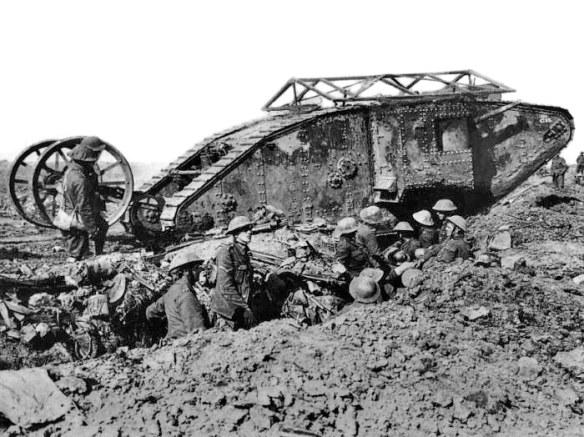British heavy tanks of WWI. British Mark I male tank Somme 25 September 1916.
On 15 September 1916, at the Battle of Flers-Courcelette, the tanks led the way on the first day of the engagement with somewhat mixed results. The effect upon the German troops who faced the tanks for the first time on that day are possibly exaggerated, but Feldwebel Weinert, serving in the 211th Prussian Infantry Regiment, clearly remembers the reaction of one of his comrades: “A man came running in … `There is a crocodile crawling into our lines!’ The poor wretch was off his head. He … imagined this giant of a machine, rearing up and dipping down as it came on, to be a monster.”‑
Though only thirty-two of the forty-nine tanks available to Haig reached their start positions, of which seven failed to start, the remaining twenty- five demonstrated just how effective the tanks could be if their reliability could be improved. Haig, though, was heavily criticized for using the tanks when so few were available. If he had waited until he had hundreds at his disposal he might well have achieved the breakthrough he sought. Some territory was won at Flers-Courcelette but it was of comparatively little significance, and for those few gains he had revealed Britain’s great secret weapon which, had it been employed in greater numbers, might well have won the war at a single stroke.
The tank had proved itself in battle and Haig ordered hundreds more to be built and their first really successful use with the British came at the Battle of Cambrai in 1917. This time Britain was able to amass 476 tanks, mostly of the new Mk. IV design (the Mk. II and Mk. III tanks were almost identical to the Mk. I with only minor changes), though less than 400 were actually engaged. The success the tanks achieved was not followed by the infantry and the overall result of the battle was unsatisfactory. The battle tank, however, had firmly established itself and henceforth would be a feature of almost every important battlefield.
The French were quick to appreciate the value of the tank and by the end of the war had produced more than any other country. The Germans, on the other hand, were far slower, producing only twenty of their ungainly A7V tanks. It was inevitable that at some point opposing tanks would meet in battle, though it was not until the last year of the war. Like British attempts at a major breakthrough, so the Germans launched their Spring Offensive in March 1918 in the hope of achieving a decisive victory. On 24 April, German artillery opened re on British and Australian positions in and around the village of Villers-Bretonneux. Just over two hours later the German attack began, led by fourteen A7V tanks.
The German tanks performed well and three of them penetrated as far as the village of Cachy where three British tanks were stationed. Alerted by an infantryman that there were German tanks in the area, Lieutenant Frank Mitchell MC of No. 1 Tank of 1st Section, `A’ Company, 1st Tank Battalion, opened a loophole to look out. “There, some three hundred yards away, a round squat-looking monster was advancing; behind it came waves of infantry, and farther away to the left and right crawled two more of these armed tortoises, so we had met our rivals at last. For the first time in history tank was encountering tank!”
A shell from Mitchell’s 6-pounder hit one of the German tanks, but the two other British tanks received return re from the enemy which tore big holes in their armour. This left Mitchell facing two A7Vs alone. To his surprise the German tanks withdrew, but it was only to allow their artillery to deal with the British tank. Both sides claimed victory.
By the end of the First World War, the Germans had learnt how to deal with the Allied tanks, having devoted considerable resources into developing anti-tank weapons. At the Battle of Amiens in August 1918, for example, 72% of the 532 vehicles of Allied Tank Corps were destroyed in the first four days.
In the decades after the First World War tanks became more heavily armed, faster and mounted ever bigger guns and would eventually come to dominate the battlefield. A hundred years on, however, their future seems limited, for it is aircraft, manned and unmanned, and missiles that are now the arbiters of victory.
